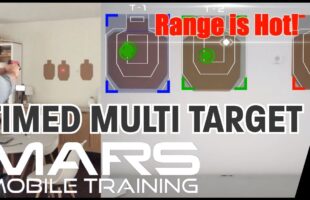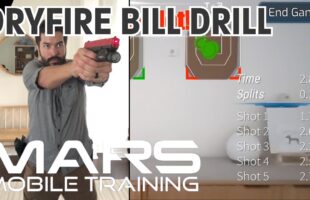What is a V-Tac or Accelerator Drill?
A V-Tac drill, also sometimes called an Accelerator Drill, is an incredibly powerful drill for testing your ability to transition between targets while combining your ability to put lots of rounds down range. Simply put, it consists in its most basic form of performing multiple target transitions while testing your ability to control and run the firearm. The drill gets its name because of the increasing rhythm of the drill. You’ll increasingly put 1 more round into each target as you move between targets, effectively “accelerating” your rate of fire (also why this is sometimes called an accelerator drill).
- You’ll shoot 1 round into the first target
- 2 rounds into the second target
- 3 rounds into the third target
- Transition back to the second target with 4 rounds
- Finish on the first target with 5 rounds
In total, if on a live fire range, you’ll fire 15 rounds. Its a very expensive drill on a live fire range, so this is where training with MARS Mobile can really save you a lot of time and money. However, the drill really is unparalleled in terms of its ability to combine skills stressed from both the Bill Drill and 2-2-2 drills in one.
How to Perform a V-Tac Drill?
Performing a Bill Drill using Dryfire with Project MARS
Project MARS supports running Bill drills at home. MARS Mobile is best used with standard “metric” USPSA targets or “classic” IPSC targets. Ideally, you’ll have a laser dry fire setup that will allow you to fire semi automatically. Check out our equipment guide for more details on the ideal dry fire setup.
- Make sure that you are dryfiring in a safe environment. Make sure there is no ammunition located anywhere in the dryfire area.
- To begin, setup any target (ideally a USPSA practice target) on your wall.
- Setup your phone with MARS Mobile, with the rear facing camera pointed at the target.
- Add at least three target areas covering your three targets.
- Select the “V-Tac Drill” mode. Begin.
- The “Are you ready?” range command will commence
- Position yourself 7 yards or so from the target
- When the shot timer rings, fire 1 shot into the first target, 2 shots into the second target, 3 shots into the third target, 4 shots again into the second target, and 5 shots into the first target, attempting to keep all shots in the center of the target (A-Zone on a USPSA Target)
- If you want to change the drill up, shoot the targets in a different order (e.g. right to left)
Interpreting the Results
If using USPSA style targets, your hit factor will be calculated based on the minor or major power factor (depending on your selected settings). Your goals for improvement with this drill will generally be as follows.
Goal 1: Improving Hit Factor
Hit factor is a concept used in USPSA to determine a shooter’s ability in a given stage as compared to other shooters. Achieving a higher hit factor is desirable. If you aren’t familiar with hit factor, read this article, as an understanding of the concept is critical to maximizing training benefits.
Just as some USPSA stages are more difficult than others, as you add more difficulty to the drill (e.g. shooting from further away, drawing from the holster, closing your eyes until the buzzer goes off), these factors will negatively impact hit factor score as they will add time to the drill. Keep this in mind as you challenge yourself more. Over time you want to see your hit factor for this drill gradually improve.
Goal 2: Shooting Speed
The main goal of the V-Tac Drill is to develop shooting speed while transitioning between targets, maintaining a combat proficient level of accuracy. You want to shoot a string of fire as quickly as you possibly can while maintaining minimum acceptable accuracy standards. At say 7 yards, an acceptable group running this drill with a 9mm pistol would be all hits within the large body A-zone.
Goal 3: Shooting Cadence
The reason for establishing shooting cadence is that it keeps you from developing bad habits and it will keep you from plateauing in terms of your speed. It’s better to go slower at first, focusing on the fundamentals of marksmanship, picking up speed gradually as you get better with a given weapons platform.
Goal 4: Maintaining Accuracy while Shooting Fast
With this drill, we aren’t worried about bullseye shooting accuracy. Rather, we’re focused on practical accuracy. We want to get lots of hits in a reasonably accurate target area, in as little time as possible, rather than getting several ultra well placed hits on each target, but taking significantly more time.
Goal 5: Controlling the weapon
Since this drill requires a high round count, you will be essentially combining the high rate of fire included in bill drills with the target transitions of a 2-2-2 Drill. This drill while simple in concept really requires you to have a master level of proficiency.
Applying the V-Tac Drill in a Live Fire Range
Finally, the whole point of dryfire is to make as many gains as possible before trying a particular skill on the live range.
A V-Tac drill on the live range isn’t so different than the V-Tac dirll while dryfiring. Keep in mind that some ranges have limits on number of targets. If this is the case, I like to use a wider paper target and section off 3 distinct areas (e.g. have 6″ circles that i’ll be shooting into at a close distance like 7 yards).
The ideal would be to have 3 separate standard USPSA targets spaced a yard or two apart in a private shooting bay. Unfortunately very few ranges have this sort of range available, so you’ll have to work with what you have available.
Practicing with MARS Mobile first will help you familiarize yourself with a V-Tac drill maximizing the benefits of live fire training. You’ll save a ton of money using MARS Mobile as at 15 rounds per set, this drill can eat through ammunition extremely fast on a live fire range.





